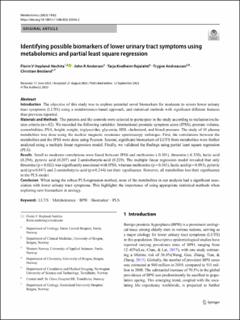| dc.description.abstract | Introduction
The objective of this study was to explore potential novel biomarkers for moderate to severe lower urinary tract symptoms (LUTS) using a metabolomics-based approach, and statistical methods with significant different features than previous reported.
Materials and Methods
The patients and the controls were selected to participate in the study according to inclusion/exclusion criteria (n = 82). We recorded the following variables: International prostatic symptom score (IPSS), prostate volume, comorbidities, PSA, height, weight, triglycerides, glycemia, HDL cholesterol, and blood pressure. The study of 41 plasma metabolites was done using the nuclear magnetic resonance spectroscopy technique. First, the correlations between the metabolites and the IPSS were done using Pearson. Second, significant biomarkers of LUTS from metabolites were further analysed using a multiple linear regression model. Finally, we validated the findings using partial least square regression (PLS).
Results
Small to moderate correlations were found between IPSS and methionine (-0.301), threonine (-0.320), lactic acid (0.294), pyruvic acid (0.207) and 2-aminobutyric-acid (0.229). The multiple linear regression model revealed that only threonine (p = 0.022) was significantly associated with IPSS, whereas methionine (p = 0.103), lactic acid (p = 0.093), pyruvic acid (p = 0.847) and 2-aminobutyric-acid (p = 0.244) lost their significance. However, all metabolites lost their significance in the PLS model.
Conclusion
When using the robust PLS-regression method, none of the metabolites in our analysis had a significant association with lower urinary tract symptoms. This highlights the importance of using appropriate statistical methods when exploring new biomarkers in urology. | en_US |

